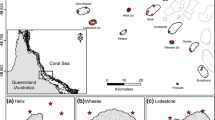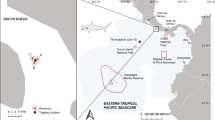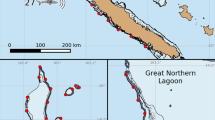Abstract
Sharks play important functional roles in coral reef ecosystems. Studying reef shark populations’ spatial ecology also contributes important data for effective conservation planning. The purpose of this study was to define the home range of neonatal blacktip reef sharks (Carcharhinus melanopterus) around Moorea, French Polynesia, and compare estimates using both mark-recapture surveys and active acoustic telemetry. Mark-recapture surveys produced a minimum convex polygon (MCP) of 0.07 km2 that was significantly larger than the MCP derived from acoustic telemetry (0.02 km2). Acoustic telemetry produced 50 and 95% kernel utilization densities that were smaller (0.02 km2) and larger (0.14 km2) than home range estimates from mark-recapture surveys, respectively. Home range estimates from this study are the smallest that have been documented for neonatal blacktip reef sharks, possibly owing to the study sites’ proximity to deep channels. Mark-recapture and active acoustic telemetry are complementary approaches worthy of consideration where passive telemetry is impractical.


Similar content being viewed by others
References
Calenge C (2006) The package adehabitat for the R software: a tool for the analysis of space and habitat use by animals. Ecol Modell 197:516–519
Chin A, Heupel M, Simpfendorfer C, Tobin A (2016) Population organisation in reef sharks: new variations in coastal habitat use by mobile marine predators. Mar Ecol Prog Ser 544:197–211
George L, Martins A, Heupel M, Simpfendorfer C (2019) Fine-scale movements of juvenile blacktip reef sharks Carcharhinus melanopterus in a shallow nearshore nursery. Mar Ecol Prog Ser 623:85–97
Heupel MR, Simpfendorfer C, Hueter RE (2004) Estimation of shark home ranges using passive monitoring techniques. Environ Biol Fishes 71:135–142
Heupel MR, Semmens JM, Hobday AJ (2006) Automated acoustic tracking of aquatic animals: scales, design and deployment of listening station arrays. Mar Freshw Res 57:1–13
Heupel MR, Kanno S, Martins APB, Simpfendorfer CA (2019) Advances in understanding the roles and benefits of nursery areas for elasmobranch populations. Mar Freshw Res 70:897
Kessel ST, Hussey NE, MacLatchey D (2015) Tonic immobility as an anaesthetic for elasmobranchs during surgical implantation procedures. Can J Fish Aquat Sci 72:1287–1291
Kiszka J, Mourier J, Gastrich K, Heithaus M (2016) Using unmanned aerial vehicles (UAVs) to investigate shark and ray densities in a shallow coral lagoon. Mar Ecol Prog Ser 560:237–242
Meyer CG, Holland KN (2001) A kayak method for tracking fish in very shallow habitats. In: Sibert JR, Nielsen JL (eds) Methods and Technologies in Fish Biology and Fisheries. Springer, Dordrecht, pp 289–296
Morrissey JF, Gruber SH (1993) Home range of juvenile lemon sharks, Negaprion brevirostris. Copeia 1993:425
Mourier J, Maynard J, Parravicini V, Ballesta L, Clua E, Domeier ML, Planes S (2016) Extreme inverted trophic pyramid of reef sharks supported by spawning groupers. Curr Biol 26:2011–2016
Oh BZL, Sequeira AMM, Meekan MG, Ruppert JLW, Meeuwig JJ (2017a) Predicting occurrence of juvenile shark habitat to improve conservation planning. Conserv Biol 31:635–645
Oh BZL, Thums M, Babcock RC, Meeuwig JJ, Pillans RD, Speed C, Meekan MG (2017b) Contrasting patterns of residency and space use of coastal sharks within a communal shark nursery. Mar Freshw Res 68:1501
Papastamatiou YP, Lowe CG, Caselle JE, Friedlander AM (2009) Scale-dependent effects of habitat on movements and path structure of reef sharks at a predator-dominated atoll. Ecology 90:996–1008
R Core Team (2018) R: A language and environment for statistical computing. R foundation for statistical computing, Vienna, Austria. URL https://www.R-project.org/
Roff G, Doropoulos C, Rogers A, Bozec YM, Krueck NC, Aurellado E, Priest M, Birrell C, Mumby PJ (2016) The ecological role of sharks on coral reefs. Trends Ecol Evol 31:395–407
Ruppert JLW, Travers MJ, Smith LL, Fortin M-J, Meekan MG (2013) Caught in the middle: Combined impacts of shark removal and coral loss on the fish communities of coral reefs. PLoS One 8:e74648
Schlaff AM, Heupel MR, Udyawer V, Simpfendorfer CA (2017) Biological and environmental effects on activity space of a common reef shark on an inshore reef. Mar Ecol Prog Ser 571:169–181
Williams JJ, Papastamatiou YP, Caselle JE, Bradley D, Jacoby DMP (2018) Mobile marine predators: an understudied source of nutrients to coral reefs in an unfished atoll. Proc R Soc B Biol Sci 285:20172456
Acknowledgements
The authors wish to thank Elodie Raimondi and staff at the CRIOBE for support during the study. Research was funded by the Laboratoire d’Excellence CORAIL, the Station d’Ecologie Expérimentale of the CRIOBE, and the French Ministère de l’Environnement. IA Bouyoucos was supported by a James Cook University Postgraduate Research Scholarship.
Author information
Authors and Affiliations
Corresponding author
Ethics declarations
Conflict of interest
On behalf of all authors, the corresponding author states that there is no conflict of interest.
Additional information
Publisher's Note
Springer Nature remains neutral with regard to jurisdictional claims in published maps and institutional affiliations.
Topic Editor Michael Lee Berumen
Rights and permissions
About this article
Cite this article
Bouyoucos, I.A., Romain, M., Azoulai, L. et al. Home range of newborn blacktip reef sharks (Carcharhinus melanopterus), as estimated using mark-recapture and acoustic telemetry. Coral Reefs 39, 1209–1214 (2020). https://doi.org/10.1007/s00338-020-01965-z
Received:
Accepted:
Published:
Issue Date:
DOI: https://doi.org/10.1007/s00338-020-01965-z




